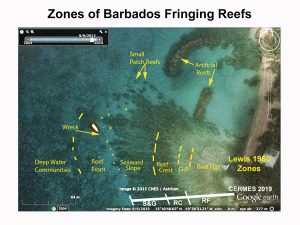Fringing Reef Zones
Subpages
– CERMES Zones
– Lewis (1960) Zones
Fringing Reefs are in simplest terms, ‘the reefs close to shore’. They are one of three major reef types, the others being Barrier Reefs and Atolls which are located some distance from shore Atolls or are separated from shore by a deep lagoon (Barrier Reefs)
Some Fringing Reefs have a shallow lagoon behind them, others (and most in Barbados) grow directly from shore. View more in Wikipedia
There are two more referenced classifications of the zones of Barbados Reefs: the CERMES (2019) classification and that of Lewis (1960). They differ mainly (i) in regard to what is included beyond the physically contiguous reef extending from shore (nothing in the CERMES classification, and 2 additional zones, the “Reef Front” and the “Deep Water Communities”, in Lewis, 1960); and (ii) Lewis describes a Diploria-Palythoa zone, not included in the CERMES classification (it is part of the CERMES’s Reef Flat zone).
I make use of Lewis’s (1960) classification in relation to my observations at Vauxhall Reef because of the detail it provides that I can reference and make comparisons to ‘on the ground’. His classification is more difficult to apply to the more degraded fringing reefs outside of the Vauxhall Reef (MPA Reef 34) as they lack some of the biological features Lewis’s describes as characteristic of the zones. So the CERMES system is more practical overall; also the CERMES zones are generally recognizable in aerial images such as on Google Earth.

